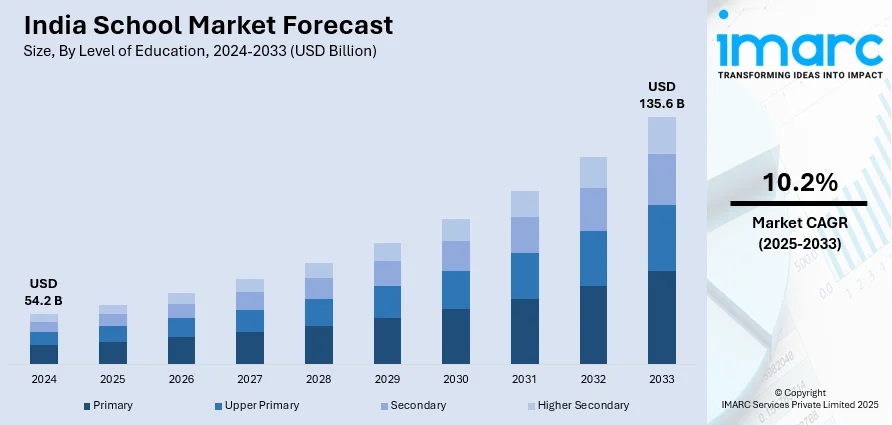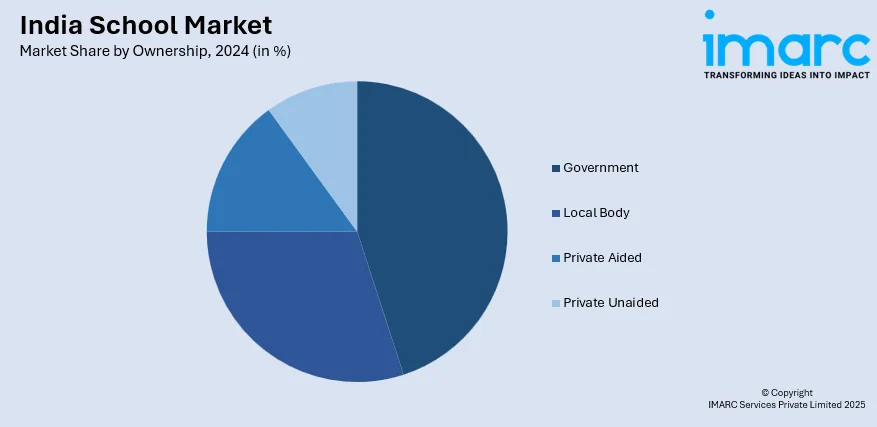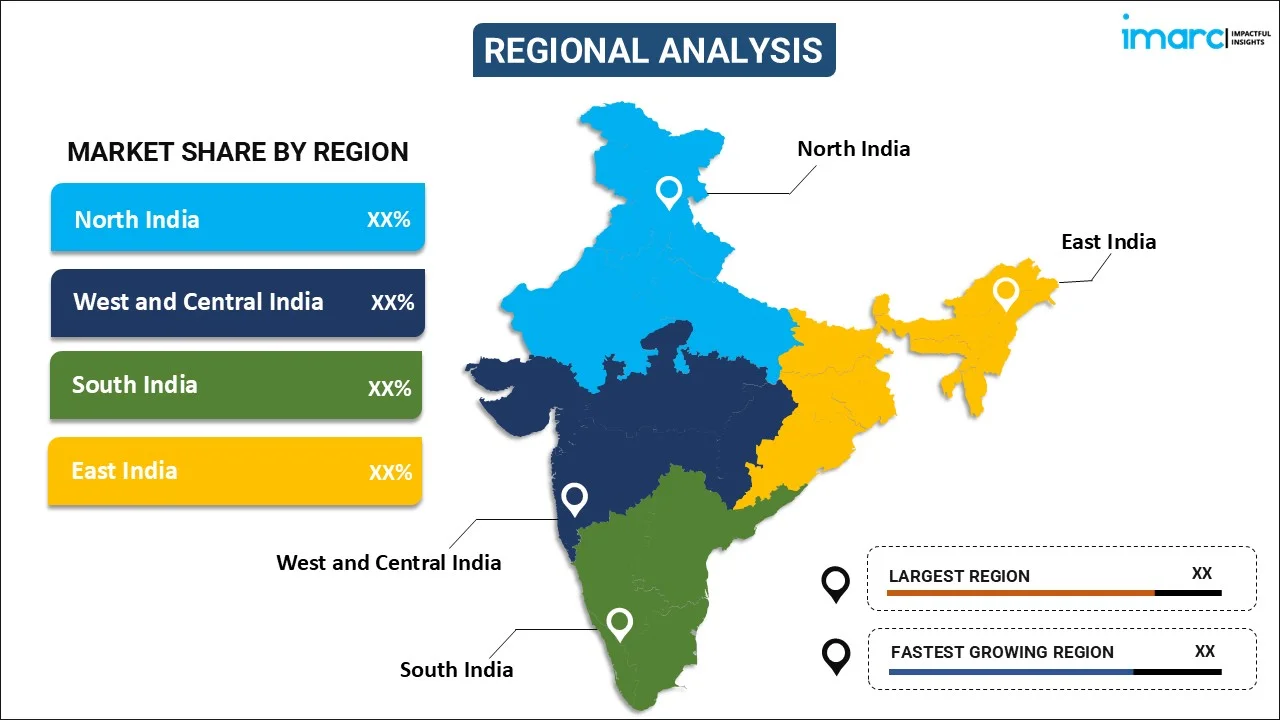
India School Market Size, Share, Trends and Forecast by Level of Education, Ownership, Board of Affiliation, Fee Structure, and Region, 2025-2033
India School Market Summary:
The India school market size reached USD 54.2 Billion in 2024. The market is expected to reach USD 135.6 Billion by 2033, exhibiting a growth rate (CAGR) of 10.2% during 2025-2033. The market growth is attributed to increasing student population, rising literacy rates, growing demand for quality education, government investments in infrastructure, digital learning adoption, and expansion of private institutions.
Market Insights:
- North India currently dominates the market in 2024.
- On the basis of level of education, the primary level of education segment leads the market in 2024.
- Based on ownership, government-owned schools lead the market in 2024.
- On the basis of the board of affiliation, state government boards lead the market in 2024.
- Based on the fee structure, the low-income segment leads the market in 2024.
Market Size & Forecast:
- 2024 Market Size: USD 54.2 Billion
- 2033 Projected Market Size: USD 135.6 Billion
- CAGR (2025-2033): 10.2%
- North India: Largest market in 2024
India holds an important place in the global education industry with around 1.55 million K-12 schools and a student base of 218 million. The Indian school system can be segmented in various categories according to the level of education provided such as preschool, primary, middle, secondary and higher secondary. On the basis of ownership, it can be segmented into government, local bodies, private aided or unaided institution and on the basis of affiliation, it can be segmented into having Indian or international board affiliations. The School education in India has traditionally been characterised by overcrowding of classes and ineffective learning for students. However, as a result of infrastructure growth, increasing private and public investments and technological advancements, the school infrastructure in the country has witnessed significant growth with the mode of teaching also shifting to digital learning and smart class formats. This has assisted the students in improving their academic performance significantly and made teaching more effective.

To get more information on this market, Request Sample
The primary factor expanding the education market size in India is the huge population in the country and a significant shortage of the number of schools to provide quality education. With a constantly growing population of around 1.37 Billion, India represents the world’s second largest populated country after China. This represents a huge consumer base for the education sector. Another factor driving the Indian school market is the significant amount of monetary support received from the government as well as private Institutions. This has resulted in significant upgradation of the education infrastructure across both rural and urban regions. Additionally, reforms such as New Education Policy (NEP), foundation of Eklavya schools, etc, introduced by the government in order to promote girl education and provide equal opportunities for all has also driven the market positively. As per the education industry analysis in India, technological advancements in the methods of teaching such as smart classes, digital libraries, augmented reality, etc, has also made learning more interactive for students, exhibiting immense scope for the India school market.
IMARC Group’s latest report provides a deep insight into the Indian school market covering all its essential aspects. This ranges from macro overview of the market to micro details of the industry performance, recent trends, key market drivers and challenges, SWOT analysis, Porter’s five forces analysis, value chain analysis, etc. This report is a must-read for entrepreneurs, investors, researchers, consultants, business strategists, and all those who have any kind of stake or are planning to foray into the Indian school market in any manner.
India School Market Trends:
Technology-Driven Classrooms and Digital Learning Ecosystems
The school education landscape in India is undergoing a transformation through the increasing adoption of technology-powered classrooms. The integration of smart boards, tablets, AR/VR-based learning modules, and AI-powered platforms is reshaping pedagogical practices across private and public institutions. These digital interventions are helping teachers deliver personalized and interactive instruction, improve learning outcomes, and bridge the urban-rural educational divide. Also, the government is also encouraging digital integration through initiatives, which offer multilingual e-content to students and teachers across states. Additionally, many schools are investing in digital libraries, cloud-based management systems, and hybrid learning infrastructure to future-proof their academic models. As of early 2025 , with internet penetration reaching 55.3%, the digital shift in education is no longer confined to metropolitan areas; Tier II and III schools are also increasingly adopting smart-classroom solutions.
Targeted Government Schemes
The National Education Policy (NEP) 2020 is a pivotal reform supporting the growth of education sector in India. Its emphasis on holistic, child-centric education and flexible curricula is leading schools to reimagine instructional approaches. The policy mandates the universalization of early childhood care and foundational literacy through programs like NIPUN Bharat, which targets basic reading and numeracy for all children by Grade 3. Moreover, the Samagra Shiksha scheme consolidates funding across the pre-primary to senior secondary levels, promoting equitable access to quality education. The government has also introduced special components for inclusive education, such as transportation allowances for differently abled students and hostels for girls from marginalized communities. Further complementing these reforms are state-level programs, like Delhi’s Happiness Curriculum or Maharashtra’s Foundational Literacy and Numeracy Mission, which aim to enhance student well-being and core competencies. These initiatives are prompting schools to invest in teacher training, experiential learning resources, and outcome-based evaluation systems, thereby aligning their operations with the evolving policy landscape.
India School Industry Segmentation:
IMARC Group provides an analysis of the key trends in each sub-segment of the India school market report, along with forecasts at the country and regional level from 2025-2033. Our report has categorized the market based on level of education, ownership, board of affiliation and fee structure.
Breakup by Level of Education:
- Primary
- Upper Primary
- Secondary
- Higher Secondary
At present, the primary level of education represents the largest segment on account of numerous programmes initiated by the Government of India for encouraging parents to send their children to primary schools. For instance, the Sarva Shiksha Abhiyan (SSA) focuses on universalizing elementary education, bridging gender and social gaps in education and enhancing the learning levels of children.
Breakup by Ownership:

- Government
- Primary
- Upper Primary
- Secondary
- Higher Secondary
- Local Body
- Primary
- Upper Primary
- Secondary
- Higher Secondary
- Private Aided
- Primary
- Upper Primary
- Secondary
- Higher Secondary
- Private Unaided
- Primary
- Upper Primary
- Secondary
- Higher Secondary
Government-owned schools account for the majority of the total market share as they provide the infrastructure for the physical and mental development of students. Some of the top government schools in the country include Kendriya Vidyalaya, Navodaya Vidyalaya, Sainik School, Military School, Air Force School, and Naval School.
Breakup by Board of Affiliation:
- Central Board of Secondary Education (CBSE)
- Council for the Indian School Certificate Examinations (CISCE)
- State Government Boards
- Others (NIOS, IBs, etc.)
Schools operating under the state government boards dominated the market as they generally charge lesser fees than CBSE schools.
Breakup by Fee Structure:
- Low-Income
- Medium-Income
- High-Income
The low-income segment holds the largest market share in the market. The fee charged by the government educational institutes, which are operated by municipal committees, corporations or schools, is very nominal. As a result, people from the lower sections of society prefer to send their children to these schools.
Breakup by Region:

- North India
- East India
- West and Central India
- South India
Amongst these, North India enjoys the leading position in the market as governing agencies are undertaking initiatives to enhance the condition of public schools of the region.
Competitive Landscape:
The competitive landscape of the industry has also been examined along with the profiles of the key players.
Latest News and Developments:
- On July 8, 2025, the Delhi Cabinet sanctioned a funding package worth INR 900 crore to enhance school infrastructure and expedite the implementation of smart classroom technologies in CM Shri Schools under the framework of the National Education Policy 2020. The fund will finance digital teaching aids, high-speed connectivity, and modern classroom amenities to enhance the quality of education and address pedagogical gaps in government schools. The initiative marks a significant step by the Delhi government to integrate technology into public education and improve learning outcomes across its school ecosystem.
- On June 14, 2025, over 5,000 underprivileged students in Kochi received educational kits under the “Back to School” initiative led by the IT employee group Progressive Techies. The campaign, now in its eighth year, provided school supplies such as bags, books, and stationery through donation boxes placed across Infopark. The initiative continues to expand its reach, building on previous efforts that included distributing digital devices during the COVID-19 pandemic.
- On May 18, 2025, the Chandigarh Administration launched a kitchen garden initiative across all government schools to foster environmental awareness and practical learning through hands-on interaction with nature. The Education Department allocated designated garden plots at each school to educate students about plant growth, sustainability, healthy eating habits, responsibility, and teamwork. Early reports indicate enthusiastic student participation, and the administration intends to scale the program further under its “My School, My Pride” slogan.
- On January 27, 2025, Lenovo India and Motorola Mobility launched the “Innovators of Tomorrow” program in partnership with Muskaan Dreams to equip government school students in Lucknow with critical 21st-century abilities such as ICT literacy, coding, and AI‑ML. The pilot will establish IoT labs and deliver a phased, hands‑on curriculum aimed at over 5,000 students in grades 6–8 across 20 schools, alongside teacher training through AI‑enabled tools. This initiative supports India’s National Education Policy 2021 by reducing the digital divide and preparing students for future employment in the rapidly growing digital economy.
Report Coverage:
| Report Features | Details |
|---|---|
| Base Year of the Analysis | 2024 |
| Historical Period | 2019-2024 |
| Forecast Period | 2025-2033 |
| Units | Million, Billion USD |
| Segment Coverage | Level of Education, Ownership, Board of Affiliation, Fee Structure, Region |
| Region Covered | North India, West and Central India, South India, East India |
| Customization Scope | 10% Free Customization |
| Post-Sale Analyst Support | 10-12 Weeks |
| Delivery Format | PDF and Excel through Email (We can also provide the editable version of the report in PPT/Word format on special request) |
Key Questions Answered in This Report
The school market in India was valued at USD 54.2 Billion in 2024.
We expect the India school market to exhibit a CAGR of 10.2% during 2025-2033.
The rising expenditures by government bodies across the country to improve the literacy rate and enhance the quality of education are primarily driving the India school market.
The sudden outbreak of the COVID-19 pandemic had led to the implementation of stringent lockdown regulations across the nation, resulting in the increasing demand for virtual and online learning platforms among numerous educational institutions, such as schools.
Based on the level of education, the India school market has been divided into primary, upper primary, secondary, and higher secondary. Among these, primary level of education currently exhibits a clear dominance in the market.
Based on the ownership, the India school market can be categorized into government, local body, private aided, and private unaided. Currently, government-owned schools account for the majority of the total market share.
Based on the board of affiliation, the India school market has been segregated into Central Board of Secondary Education (CBSE), Council for the Indian School Certificate Examinations (CISCE), state government boards, and others (NIOS, IBs, etc.). Among these, state government boards currently hold the largest market share.
Based on the fee structure, the India school market can be bifurcated into low-income, medium-income, and high-income. Currently, the low-income segment exhibits a clear dominance in the market.
On a regional level, the market has been classified into North India, East India, West and Central India, and South India, where North India currently dominates the India school market.
Need more help?
- Speak to our experienced analysts for insights on the current market scenarios.
- Include additional segments and countries to customize the report as per your requirement.
- Gain an unparalleled competitive advantage in your domain by understanding how to utilize the report and positively impacting your operations and revenue.
- For further assistance, please connect with our analysts.
 Request Customization
Request Customization
 Speak to an Analyst
Speak to an Analyst
 Request Brochure
Request Brochure
 Inquire Before Buying
Inquire Before Buying




.webp)




.webp)












